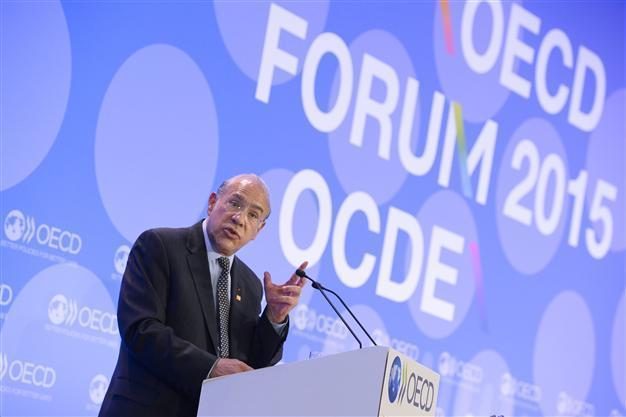OECD cuts Turkey’s growth outlook by 0.1 percent
PARIS

AFP Photo
The Organisation for Economic Co-operation and Development (OECD) cut Turkey’s growth forecast for 2015 to 3.1 percent from 3.2 percent, the organization said in a report released on June 3.“Growth weakened in Turkey in early 2015, after a short-lived upturn in late 2014. The uncertainties associated with the forthcoming legislative elections and ongoing geopolitical tensions in the region are holding back investment and consumption spending,” the report said.
“GDP growth is projected to pick up gradually over 2015 and 2016, after the ‘wait and see’ attitudes of businesses and households dissipate, but to remain below potential,” it added.
The OECD also lowered its 2016 growth forecast for Turkey from 4 percent to 3.9 percent.
The Paris-based think tank, funded by its membership of primarily wealthy countries, cut its 2015 global growth forecast much more sharply, to 3.1 percent from the 3.7 percent it was forecasting last November. It also said it expected a rise in the pace of global GDP growth of 3.8 percent in 2016.
The OECD has said it expects lower oil prices to ensure a gradual recovery, even if weak investment remains a worry.
Growth is also being buoyed by ultra-supportive central bank policies in the large developed economies and in many places outside the United States by a stronger dollar, which makes the exports of other currency zones relatively cheaper, it added.
U.S. growth, which dipped notably in early 2015, is now seen at 2.0 percent for the year, marginally lower than last year’s 2.2 percent, before picking up to 2.8 percent in 2016.
Aided by the triple-boost of cheaper oil, European Central Bank asset-buying and the rise in the dollar exchange rate, the eurozone countries are expected to post GDP growth of 1.4 percent this year and 2.1 percent next year, the OECD said.
Ultra-supportive central bank policies have been aiding both the U.S. and European economies, and also Japan, where GDP this year is expected to be 0.7 percent, before 1.4 percent in 2016.
While commending the monetary policy responses and saying it saw oil prices adding a quarter of a percentage point to growth rates in both 2015 and 2016, the OECD voiced concern.
“The main reason for the weakness in investment is the weak recovery itself and doubts over the prospects for stronger growth,” the OECD said.
“There are also specific reasons for individual countries: Still tight lending conditions in parts of Europe, lower oil prices in North America, past investment excesses in China and continued adjustment in housing in much of the OECD,” the report said.
The International Monetary Fund (IMF) last January trimmed its global growth forecasts by 0.3 points for both 2015 and 2016 to 3.5 and 3.7 percent respectively - not far off the OECD’s numbers.
















